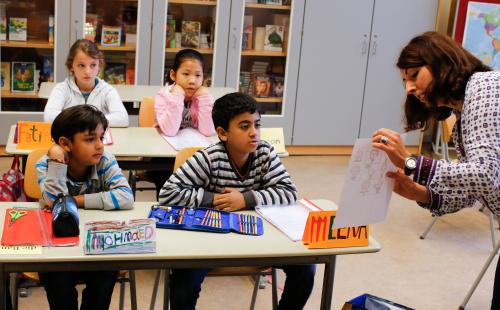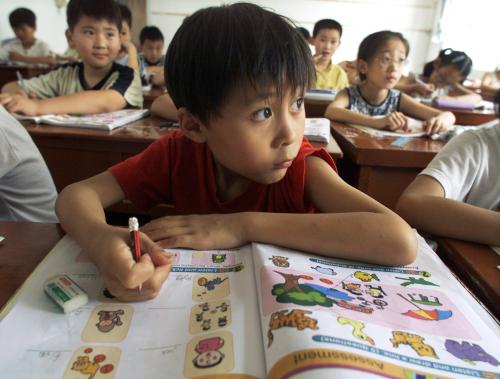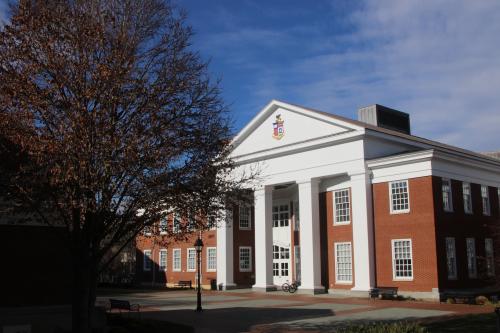The Department of Defense Education Activity (DoDEA) reached a historic milestone in its student performance in the 2022 National Assessment of Educational Progress. In the 2022 NAEP assessment, DoDEA outperformed all states in reading and math in both 4th and 8th grade. Over the last decade, both before and after the outbreak of COVID-19 (when DoDEA schools remained open), DoDEA’s academic climb—shown below in Figure 1—has been remarkable.
How did DoDEA persistently improve its academic performance through such a challenging period? I’ve spent the last year interviewing DoDEA leadership and educators, participating in planning meetings, visiting districts and schools, and analyzing policy documents in hopes of answering this question.
Here, I discuss what I’ve found. I describe the organizational, policy, and leadership factors that contributed to DoDEA’s improving performance—looking at both what’s working for DoDEA and what other states and districts might learn from DoDEA’s journey. What I’ve found is that DoDEA has effectively (and simultaneously) undertaken two major improvement strategies during this period: an organizational transformation that increased coherence in its academic standards and a long-term investment in improving instruction.
The unique history and organization of DoDEA schools
In the wake of World War II, the U.S. Department of Defense established DoDEA schools to provide stable, high-quality educational opportunities to the highly mobile children of U.S. servicemembers stationed overseas. As of January 2023, DoDEA enrolled approximately 67,000 students across 160 schools in grades pre-K through 12.
DoDEA is unusual among public school systems in several ways. First, DoDEA is operated directly by the federal government, not governed by an elected or appointed board of education like other systems. Second, DoDEA schools are rooted in the mission, culture, and organization of the armed services. There’s a military-style chain of command, and military supervisors handle student behavioral issues, leaving teachers to focus on teaching and learning. Third, DoDEA enjoys a multiyear budgetary commitment and allocations from the Military Construction Program to modernize its school facilities, whereas other state and district systems must go through annual budgetary cycles and gain voter support for capital projects. This enables DoDEA to undertake longer-term budgetary planning in its educational initiatives.
Issues: Organizational fragmentation and incoherent implementation
Notwithstanding its unique history and organization, DoDEA faces some challenges that are familiar to many states and large districts. DoDEA’s geographically dispersed campuses—across nations, cultures, and time zones—are vulnerable to organizational fragmentation and disjointedness in policy implementation. DoDEA-Americas operates 50 schools, spanning places as different as Cuba and Kentucky. DoDEA-Europe operates another 64 schools across four time zones, while DoDEA-Pacific has 45 schools of its own. (DoDEA also operates a virtual school.)
In September 2012, DoDEA commissioned Booz Allen Hamilton and the Council of Chief State School Officers (CCSSO) to conduct a strategic review to examine issues at the “above-school” level. The review found significant challenges hindering DoDEA. Headquarters (HQ) was overly involved in day-to-day operations, at the expense of focusing on policy and standards. DoDEA’s academic standards, curriculum, and assessment were weakly aligned both across and within regions, professional development opportunities were lacking, and there was limited organizational accountability and collective ownership.
Organizational transformation and an investment in instructional improvement
In his first 100 days after arriving in March 2014, DoDEA Director Tom Brady established the vision of “One DoDEA.” Director Brady’s vision directly challenged the fragmentary state of DoDEA at the time. In 2013, DoDEA had three distinct regional systems—Europe, Pacific, and Americas. Each of the three regional systems operated independently with its own curriculum and services. The regionalized system could seem like three autonomous DoDEAs.
Since 2014, DoDEA has launched initiatives that integrate the regions into a coherent, unified system; restructure the coordinative functions of the above-school level; and redesign the relationship between schools and the above-school level. Leadership longevity matters. In his decade-long tenure, Director Brady recruited a leadership team that assumed responsibility for steering the complex organization toward his vision of One DoDEA. In succeeding Brady as DoDEA’s Director in June 2024, Dr. Beth Schiavino-Narvaez, formerly DoDEA’s Chief Academic Officer, is well positioned to build on this progress.
DoDEA has undertaken ambitious initiatives to improve instruction in recent years. One clear example is the adoption and implementation of College and Career Ready Standards (CCRS). DoDEA strategically rolled out CCRS in phases, focusing on standards-based improvement, assessments, and professional development. Based on NAEP performance showing that DoDEA’s math performance lingered around the middle of all state systems, DoDEA’s leadership recognized the need for improvement in math. In 2015-2016, DoDEA launched its first CCRS initiative with a focus on pre-K-5th grade math. This priority-setting action was followed by the implementation of math CCRS standards in grades 6 through 12 the following year and standards in other subject areas in subsequent years. The adoption of CCRS represents efforts from the above-school level to support the instructional core at the school and classroom level. DoDEA’s commitment to standards-based instruction is approaching its 10th year, and there is no sign of changing course.
With a similar motivation to strengthen the instructional core, DoDEA launched Restructuring for Student Achievement (RSA) in 2016. RSA clarifies the functions and responsibilities of various units in supporting schools. Further, regional Centers for Instructional Leadership (CILs) were established to support systemic leadership development, create professional development aligned with DoDEA priorities, facilitate learning networks throughout the organization, and nurture innovative practices. Instructional Support Specialists (ISSs) provide coaching and content-area support to teachers across all districts and schools in DoDEA. During the pandemic, ISSs provided critical support to ensure instructional consistency so that students were not falling behind in their lessons. ISSs also design coaching sessions based on information gathered in classroom observations. Notably, recent accreditation reviews found that DoDEA districts outperformed their comparison group in multiple aspects of education quality.
More recently, DoDEA’s Teacher Hiring Project has focused on ensuring that every classroom has a qualified teacher on the first day of school. Like other public-school systems, teacher hiring in DoDEA involves centralized HR functions and a decentralized process of candidate interviews at the school sites. To improve coordination and efficiency, the initiative provides regions and districts with a hiring data dashboard, process mapping, analysis of requests for personnel action (RPA), FAQ guides for hiring managers, and a review of certificate selection issues. Early implementation shows promising results. At the start of the 2022 and 2023 school years, 63% and 73% of the vacant teaching positions were filled, respectively. Between July 2022 and July 2023, spring semester requests to recruit a teacher improved by 58%, teacher selections by summer improved by 148%, and entry on duty (or report date by first day of school) improved by 272%.
Congressional appropriations to continuously support the construction of modern learning facilities constitute another key sustaining condition. With the goal of supporting effective learning for every student, 21st-Century Facilities are characterized by features that include flexible, adaptable structures and space and a learning environment that provides hands-on learning opportunities to develop skills in real-world problem solving.
Commitment to instructional quality and implementation consistency have been important elements in sustaining DoDEA’s improvement. Importantly, to build and sustain a collective ownership on its priorities, DoDEA utilizes a comprehensive, annual planning cycle that offers plenty of opportunity for reflection, analysis, and feedback. This cycle starts with the regional leadership summit in August and continues with planning meetings involving regional and district leaders, CILs, and other HQ administrators. At the Winter Planning Meeting in March 2024 that I attended, regional directors and district superintendents gathered in DoDEA HQ for several days to reflect on their practice and progress as well as provide feedback to HQ leaders on key issues. The discussion was fully informed by student assessment data, classroom observation, and surveys. An outcome of the Winter Planning Meeting is a list of “shared agreements” on priorities and actions planned for the next academic year. These “shared agreements” are further discussed and finalized in the Summer Planning Meeting in June. The cycle repeats again the following year.
Policy implications for state and district school systems
This case study of DoDEA has implications for state and district school systems, even though the research is not designed to establish causal relationship between specific organizational changes and student achievement. First, DoDEA’s planning and learning cycle provides a good model for engaging regional and district leaders to build collective commitment and organizational trust. State chiefs could organize retreats with district superintendents and their key staff across the state to reflect as communities of practice and engage state leadership on key policy issues. Perhaps DoDEA’s “shared agreements” could serve as a model for where those retreats lead. This kind of convening can build on the work of statewide councils of districts and superintendents.
Second, although multiyear budgetary planning is difficult to replicate in other state education systems—which are governed by annual or biannual budgetary approval processes—state legislatures could consider adopting multiyear budget guidelines based on enrollment projections and revenue trends. Collective bargaining agreements for educators and other staff are often multiyear, while most educational initiatives face annual budgetary review. A framework on all budgetary items across a longer timespan could improve data-driven planning and transparency. This would need to be adjusted and finalized annually by the legislature, but it could help districts undertake longer-term planning of major initiatives and avoid fiscal surprises.
Finally, DoDEA’s sustained academic progress points to the importance of a steady, long-term focus on a standards-based instructional core. Playing the long game is difficult in states and districts that experience frequent leadership turnover. To mitigate the inertia of “policy churn,” institutions with frequent leadership turnover could partner with governing institutions with more stable leadership. For example, a district with frequent superintendent turnover may partner with the state chief, the mayor, or a local university to ensure there is sufficient capacity and institutional memory to implement its academic priorities. After all, DoDEA’s performance over the last decade suggests that a sustained focus on the instructional core could yield strong learning results.
-
Acknowledgements and disclosures
The author acknowledges the research assistance provided by Kea Bekkedahl at Brown University and the support provided by DoDEA.







Commentary
Public school systems can learn a lot from the Department of Defense Education Activity
July 15, 2024